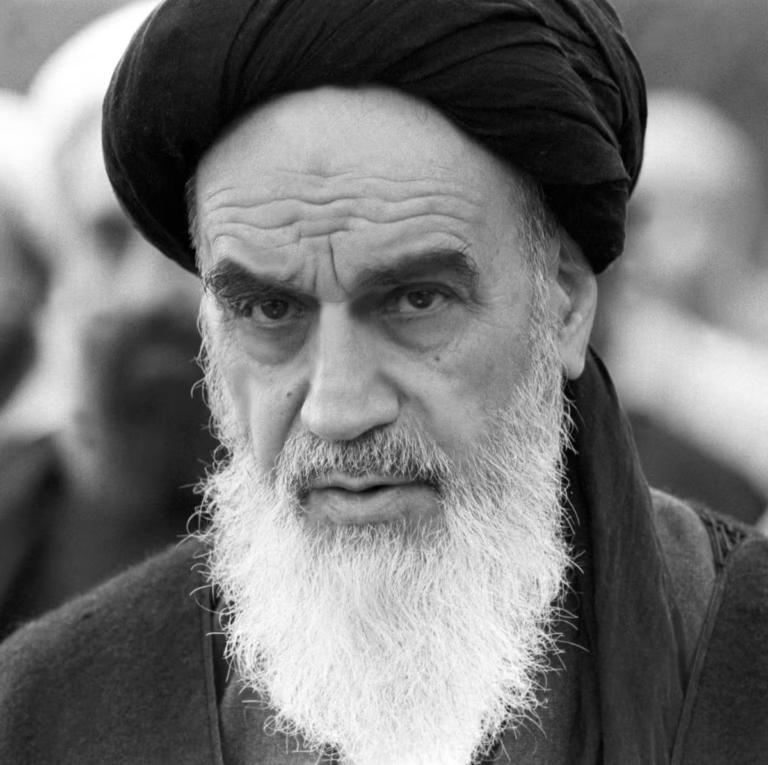Ayatollah Ruhollah Khomeini was one of the most influential figures in modern Middle Eastern history. Born on September 24, 1902, in the small town of Khomein in Iran, Khomeini would go on to lead a revolution that transformed Iran from a monarchy into an Islamic republic. He was a Shia cleric who spent decades studying and teaching Islamic philosophy, jurisprudence, and mysticism. His views combined deep religious conviction with a powerful political vision, and his ideas continue to shape Iranian society today.
Khomeini first came to prominence in the early 1960s when he began speaking out against the policies of Shah Mohammad Reza Pahlavi. He strongly opposed the Shah’s White Revolution, a series of Western-backed reforms that included land redistribution and women’s rights. Khomeini saw these changes as a direct attack on Islamic values and Iranian traditions. In 1964, after openly criticizing the Shah and his alliance with the United States, he was arrested and later exiled. This exile lasted for over 14 years, during which Khomeini lived in Turkey, Iraq, and finally France.
While in exile, Khomeini continued to speak to the Iranian people through writings and audio recordings. His messages called for the overthrow of the monarchy and the establishment of a government based on Islamic principles. His central idea, known as “Velayat-e Faqih” or “Guardianship of the Islamic Jurist,” argued that a qualified Islamic cleric should have authority over the state in the absence of the Twelfth Imam. This concept later became the foundation of the new Iranian Constitution.
The 1979 Iranian Revolution marked a turning point in Iran’s history. Mass protests and strikes led to the fall of the Shah’s regime. On February 1, 1979, Khomeini returned to Iran to a hero’s welcome. Within weeks, he established an Islamic Republic following a national referendum. He was declared Iran’s first Supreme Leader, a role that gave him the highest authority over all aspects of Iranian life, including government, religion, and the military.
Under Khomeini’s leadership, Iran experienced significant changes. Western influence was largely removed, and Islamic laws were strictly enforced. Universities, media, and public life were reshaped to align with Islamic teachings. One of the most dramatic events during his rule was the U.S. embassy hostage crisis. In November 1979, Iranian students took 52 American diplomats hostage for 444 days. Khomeini supported the takeover, which greatly damaged U.S.-Iran relations.
Another major event of his leadership was the Iran-Iraq War, which lasted from 1980 to 1988. The war began when Iraqi leader Saddam Hussein invaded Iran, expecting a quick victory. Instead, Iran fought back fiercely under Khomeini’s direction, leading to a long and devastating conflict with no clear winner. The war resulted in hundreds of thousands of deaths and widespread destruction.
In 1989, Khomeini issued a religious ruling, or fatwa, against British author Salman Rushdie for his book “The Satanic Verses,” which he deemed blasphemous. The fatwa called for Rushdie’s death and led to global controversy. Khomeini’s decision highlighted his willingness to use religious authority far beyond Iran’s borders.
Khomeini died on June 3, 1989, at the age of 86. His funeral drew millions of mourners, making it one of the largest in history. He was buried at Behesht-e Zahra cemetery in Tehran, where a massive shrine was later built in his honor. After his death, Ayatollah Ali Khamenei succeeded him as Supreme Leader.
Ayatollah Ruhollah Khomeini left behind a complex legacy. To his supporters, he was a spiritual guide and revolutionary hero who stood against Western imperialism. To his critics, he was a strict authoritarian who suppressed dissent and limited personal freedoms. Regardless of viewpoint, Khomeini remains a towering figure in Iranian and Islamic history, whose influence is still felt in the region today.







